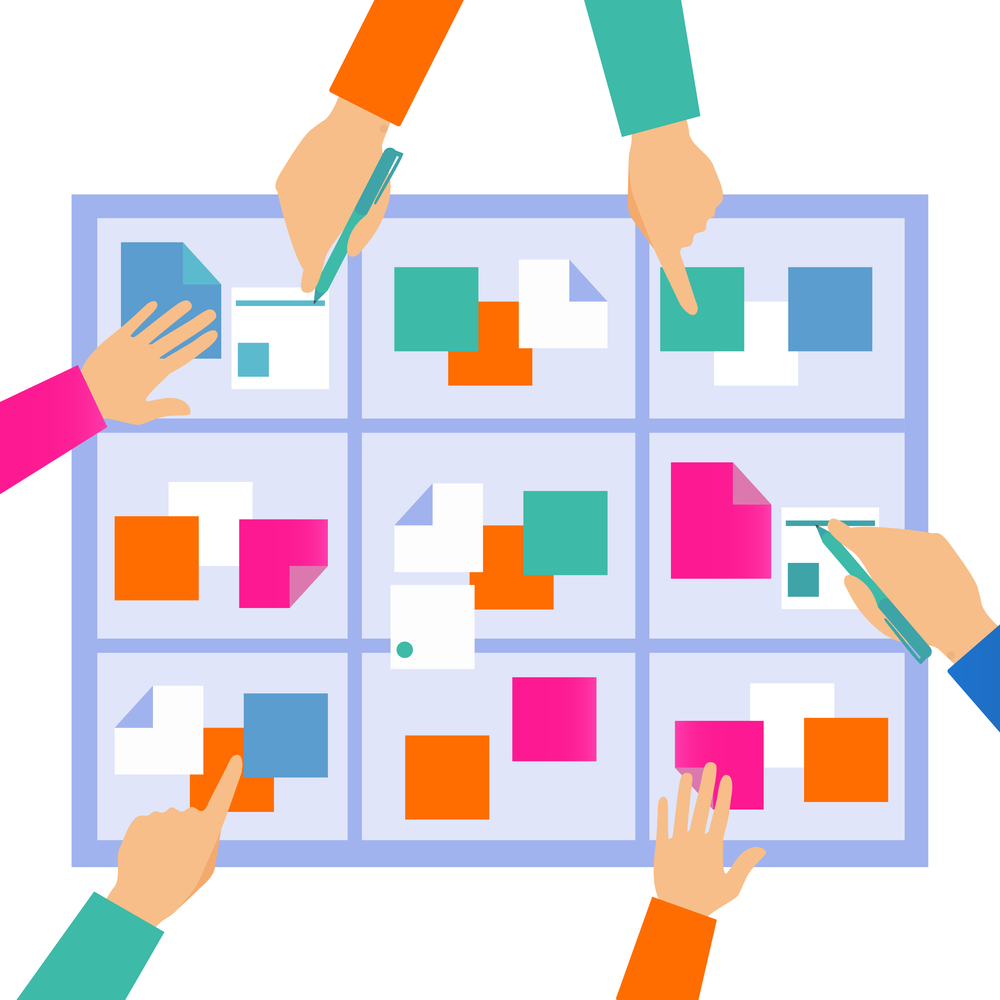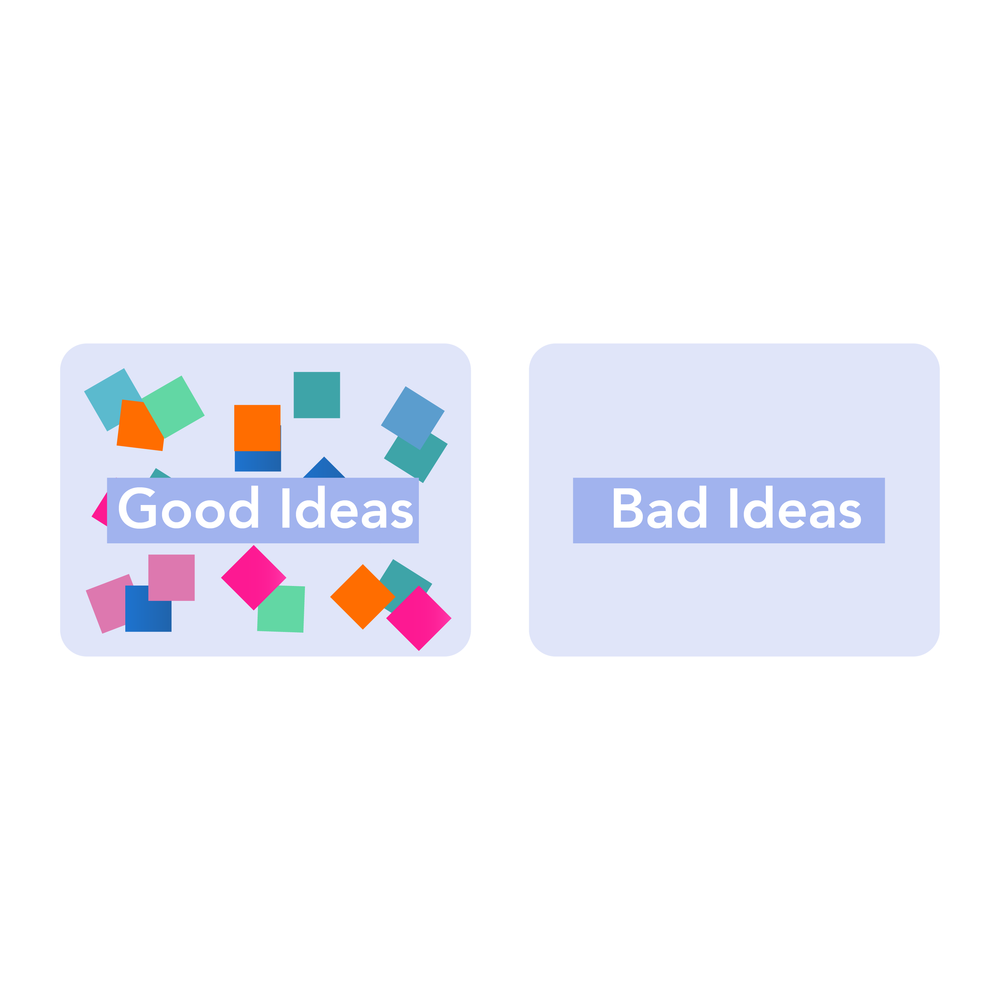Digital idea board: how to create and use one with your team

If you’ve been following our blog for a while, you’ll already be up to speed with amazing tricks to facilitate brainstorming sessions, get the best out of dot voting and the benefits of affinity grouping.
Today, we’re going to tell you about a tool that draws on all of these concepts to make your ideation sessions engaging, productive and fun.
What is an idea board?
An idea board is exactly what it sounds like, a board for ideas. Think mood boards in interior design or a series of sketches an artist does in preparation for a big piece.
In Agile, idea boards are the sum of your team’s imaginative efforts to achieve a common goal or solve a common problem. They’re also a great way to get the entire team excited about the upcoming sprint. Much more so than a typical verbal ideation session.
As scrum master you’re looking for as many ideas as possible so you can find the best way to approach the next batch of work. An idea board is perfect for encouraging cross-pollination of ideas and engaging your whole team in the decision-making process.
So, what do you need to create an idea board? The good news is that the concept is super flexible and can be presented on any of the following:
- Whiteboards
- Walls
- Glass
- Paper
- Digital Whiteboards
- Device Screens
Don’t forget to consider the new remote working culture when planning your idea boards. Having shared online idea boards ensures easy access for your team, regardless of where they are in the world.
When can you use an idea board?
Idea boards are incredibly adaptive, simple, and fun for the entire team.
They can be used to gather ideas for:
-Problem solving -Marketing concepts -Event ideas (e.g., office parties, workshops, seminars) -Product Names -Improvements for existing products -Visual themes for a product’s UX
You can even use an idea board during sprint retrospectives or post-mortems to improve workflow for future sprints. Basically, if you need ideas from your team, it’s time to break out the idea board!
Idea board sessions are a great way to get the team excited about the weeks ahead. It’s a great team building opportunity as ideas flow. Team members feed off each other to create amazing solutions to potential problems or create a new feature that elevates the project to the next level.
So, not only does an idea board session help with team building, but it also gives the team a greater sense of ownership and pride over the project. Ready to learn how to slot this awesome concept into your Agile workflow?
How to make an idea board
1. Have a specific goal in mind
This might seem obvious, but for an ideation session to work you need something to work towards. If you simply walk into a meeting and ask for ideas, you’re going to be met with blank faces and a lot of questions.
When you schedule a brainstorming session, make sure to include the purpose of the meeting in the memo or on the calendar (ideally both). That way, everyone knows what needs to go on the idea board before they go in.
2. Choose a format
There are a couple of ways to run an idea board session. Both have their benefits, and both have their drawbacks, so this decision will be based on how your team works.
Format 1: Scribe
This format feels more like a traditional brainstorming session. Team members will verbally present their ideas as a designated scribe writes them down and places the idea on the board. The scribe can then use affinity grouping to organize ideas by category, or simply list the ideas as they’re presented.
This format relies on a “one-at-a-time” flow, offering whoever is floating the idea a chance to explain their concept further. However, it does present a barrier for the quieter team members as they have to find a suitable gap in the conversation before speaking up, which may not happen at all.

Format 2: Group
The group format is far more inclusive. Everyone is given their own sticky notes and can add their ideas as and when they please. This encourages more ideas but less discussion during the session and can be quite chaotic if held in the office.
However, it works brilliantly for online idea boards as everyone can add ideas instantly. Less time spent gathering ideas means more time left for the latter (arguably more interesting) stages of the session.
3. Ideation
As the ideation session begins, make sure to refresh the team on what the aim of the meeting is and what ideas you’re looking for. Then — depending on which format you choose — it’s time to get the ideas flowing.
An idea board doesn’t have to only include text: it can include visual cues too! Using sticky notes is a great way of incorporating visuals because your team members can doodle their ideas instead of trying to verbally explain them. Anyone wishing to upload a visual suggestion to an online idea board simply needs to embed or link to the image.
As scrum master, you’ll need to oversee the session to ensure everyone is involved. If any of your team looks like they’re waiting to speak up, but can’t find the right time, create an opportunity for them to speak.
4. Provide positive feedback
During these sessions, the aim is to get as many ideas as possible that can help in the upcoming sprint. Not only does this mean that no idea is to be dismissed, but the facilitator should be offering positive reinforcement to encourage the rest of the team.
Shutting down an idea (even one that doesn’t seem immediately useful) can quickly ruin the creative vibe and guarantees the more introverted team members will stay silent.

Offering positive feedback on each idea makes your team feel valued and creates a much more comfortable vibe for the rest of the project. Sessions like this double as a team building exercise, so try and make your team come out of the meeting with a sense of validation and pride.
5. Prioritize
As the ideation session comes to an end, it’s time to evaluate which ideas to take forward.
Firstly, the group needs to identify ideas that may be unsuitable for the upcoming sprint. That’s not to say these ideas wouldn’t work later on, so maybe create a “save for later” column so you can come back to them during the next sprint.
This will leave you with the ideas that would work. Now you can organize the remaining ideas into affinity groups or organize a dot voting session to choose what to work on.
Digital idea boards in EasyRetro
It probably won’t surprise you to know that EasyRetro is the perfect platform to host your idea boards! By creating your idea board online with EasyRetro, you’ll unlock a range of benefits to make your life easier, especially while working remotely.
Benefits of an online idea board include:
- Realtime updates
- Easy sharing
- Access anywhere
- Effortless organization with drag and drop functionality
- Cloud storage (no more misplaced USB drives or accidentally shredded documents)
- Easy to read (no messy handwriting)
Finally, when it comes to the post-sprint retrospective, you already have a board set up ready with all the ideas from the sprint. All you need to do is discuss the ideas and arrange them into what went well and what didn’t.
Making your retrospectives easier and more fun is what EasyRetro was built for, but that’s not all. By joining us, you gain access to thousands of templates, amazing advice, and plenty of great tools to make sprint management a breeze.
So, what are you waiting for? Get started with EasyRetro today for free!